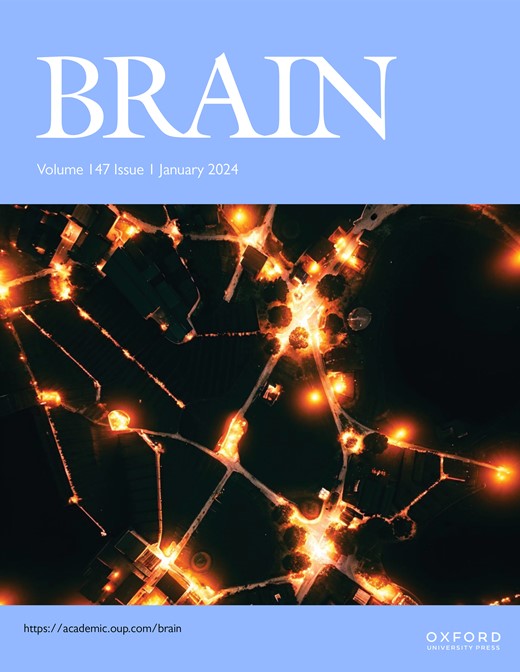Amygdalar and hippocampal volume loss in limbic-predominant age-related TDP-43 encephalopathy
IF 11.7
1区 医学
Q1 CLINICAL NEUROLOGY
引用次数: 0
Abstract
Limbic-predominant age-related TAR-DNA binding protein (TDP-43) encephalopathy neuropathological change (LATE-NC) refers to the aberrant accumulation of TDP-43 in the brains of aging individuals either in isolation or in combination with neurodegenerative disease. LATE-NC is most commonly found in the amygdala and hippocampus and is associated with progressive amnestic decline in individuals with a neurodegenerative disease. Since LATE-NC can only be diagnosed post-mortem, there is a need for pathology-validated neuroimaging biomarkers for LATE-NC. In the current study we assessed MRI-measured amygdalar and hippocampal volume in brain donors with Alzheimer’s disease or Lewy Body diseases with and without co-occurring LATE-NC pathology. Post-mortem in-situ 3D-T1 3T-MRI data were collected for 51 cases (27 Alzheimer’s disease and 24 Lewy Body Disease) of whom 17 had post-mortem confirmed LATE-NC and 34 were non-LATE-NC (matched on age, sex, and neurodegenerative disease). Amygdalar and hippocampal volumes were calculated using FreeSurfer. Within-subject amygdalar and hippocampal tissue sections were immunostained for TDP-43 (pTDP-43), phosphorylated tau (AT8), amyloid-β (4G8) and α-synuclein (pSer129). Positive cell density (TDP-43 and α-synuclein) and area percentage immunoreactivity (p-tau and amyloid-β) outcome measures were quantified using QuPath. Group differences between LATE-NC and non-LATE-NC donors were assessed with univariate analyses and correlations were assessed with linear regression models, all adjusting for intracranial volume and post-mortem delay and if applicable for primary pathology. Brain donors with LATE-NC showed significantly lower amygdalar (-26%, p=.014) and hippocampal (-19%, p=.003) volumes than non-LATE-NC brain donors, even when correcting for regional phosphorylated tau, amyloid-β and α-synuclein burden. These group differences remained significant in the Alzheimer’s disease group (amygdala -24%, p=.028; hippocampus -21%, p=.002), but in the Lewy body diseases group only the amygdala was smaller in LATE-NC donors compared to non-LATE-NC donors (18%, p=.030). These results suggest that severity of TDP-43 burden plays a role in amygdala and hippocampus atrophy on MRI, even when correcting for effects of primary pathology. This study proposes that exceptionally low amygdalar and hippocampal volumes could indicate LATE-NC and that this may serve as a potential biomarker for in-vivo studies.边缘显性年龄相关性TDP-43脑病的杏仁核和海马体积损失
脑边缘显性年龄相关TAR-DNA结合蛋白(TDP-43)脑病神经病理改变(LATE-NC)是指TDP-43在老年个体大脑中单独或合并神经退行性疾病的异常积累。LATE-NC最常见于杏仁核和海马体,与神经退行性疾病患者的进行性遗忘衰退有关。由于晚期nc只能在死后诊断,因此需要经过病理验证的晚期nc神经成像生物标志物。在当前的研究中,我们评估了伴有或不伴有晚期nc病理的阿尔茨海默病或路易体病脑供体的mri测量的杏仁核和海马体积。我们收集了51例(27例阿尔茨海默病和24例路易体病)的死后原位3D-T1 3T-MRI数据,其中17例死后确诊为晚期nc, 34例非晚期nc(年龄、性别和神经退行性疾病相匹配)。使用FreeSurfer计算杏仁核和海马体积。实验对象的杏仁核和海马组织切片免疫染色检测TDP-43 (pTDP-43)、磷酸化tau (AT8)、淀粉样蛋白-β (4G8)和α-突触核蛋白(pSer129)。使用QuPath量化阳性细胞密度(TDP-43和α-突触核蛋白)和面积百分比免疫反应性(p-tau和淀粉样蛋白-β)指标。采用单变量分析评估LATE-NC和非LATE-NC供体的组间差异,并采用线性回归模型评估相关性,所有模型均调整颅内容量和死后延迟,如果适用于原发病理。即使校正了区域磷酸化的tau、淀粉样蛋白-β和α-突触核蛋白负荷,LATE-NC脑供者的杏仁核(-26%,p= 0.014)和海马(-19%,p= 0.003)体积也显著低于非LATE-NC脑供者。这些组间差异在阿尔茨海默病组中仍然显著(杏仁核-24%,p= 0.028;海马-21%,p=.002),但在路易体疾病组中,只有LATE-NC供者的杏仁核比非LATE-NC供者小(18%,p=.030)。这些结果表明,在MRI上,TDP-43负荷的严重程度在杏仁核和海马萎缩中起作用,即使校正了原发病理的影响。这项研究提出,异常低的杏仁核和海马体积可能表明晚期nc,这可能作为体内研究的潜在生物标志物。
本文章由计算机程序翻译,如有差异,请以英文原文为准。
求助全文
约1分钟内获得全文
求助全文
来源期刊

Brain
医学-临床神经学
CiteScore
20.30
自引率
4.10%
发文量
458
审稿时长
3-6 weeks
期刊介绍:
Brain, a journal focused on clinical neurology and translational neuroscience, has been publishing landmark papers since 1878. The journal aims to expand its scope by including studies that shed light on disease mechanisms and conducting innovative clinical trials for brain disorders. With a wide range of topics covered, the Editorial Board represents the international readership and diverse coverage of the journal. Accepted articles are promptly posted online, typically within a few weeks of acceptance. As of 2022, Brain holds an impressive impact factor of 14.5, according to the Journal Citation Reports.
 求助内容:
求助内容: 应助结果提醒方式:
应助结果提醒方式:


